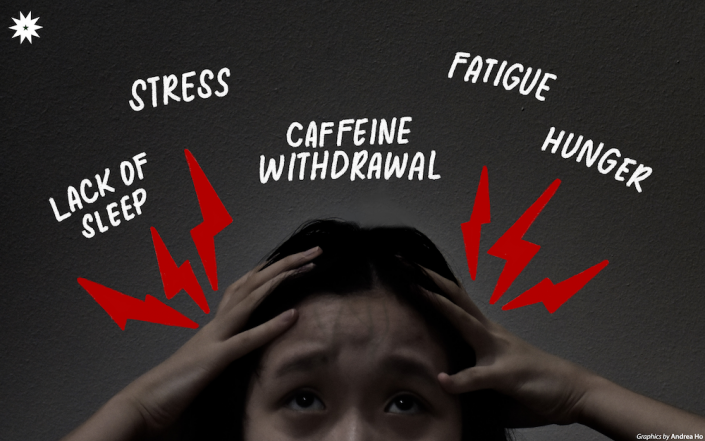A trigger is what starts it all.
In what seems like an assault to the senses, one’s head hurts and the head and neck muscles tighten as a reaction to the trigger. What follows would be the brain’s electrical activity changing the flow of blood, affecting sensitive nerve endings and creating pain. This is what happens in the body when one experiences a migraine.
Described as a throbbing or pulsating pain that can possess moderate to severe intensity, migraines may be accompanied by nausea, vomiting, and extreme sensitivity to light and sound. Migraines can be triggered by skipping meals, menstruation, emotional stress, physical stress, and external stimuli like glaring or flickering lights, loud noise, intense smell, extreme heat, change of weather, among others.
It is a common misconception that these migraines are “all in our heads.” But there is more to migraines than what people usually think.

A pain in the head
By technicality, a migraine is a type of headache.
Headaches, as their name implies, are a sensation of pain in any region of one’s head. They may occur on either side of the head, be isolated in a certain location, radiate across the head from one point, or have a viselike quality. They also have different types, such as tension headache, migraine, rebound headaches, among many others, which also have a variety of triggers that range from stress, sleep deprivation, and fatigue, to external stimuli such as flickering lights, loud noise, and heat.
However, headaches mainly fall into two categories: primary and secondary, depending on whether or not there is an underlying cause. Primary headaches such as tension, cluster, and migraine headaches have “no underlying cause,” says Dr. Martha Bolanos, a neurologist from the Philippine Neurological Association. On the other hand, secondary headaches, meanwhile, are brought upon by conditions such as “stroke, trauma, meningitis, and brain tumors,” she cites. Pain from caffeine withdrawal, post-traumatic stress, and those caused by other medical conditions also fall under the second category.
Signs and signals
In terms of symptoms, a migraine can be detected in approximately 25 to 30 percent of people experiencing such a headache through auras. Auras are sensory disturbances that can last from 20 to 60 minutes and may be experienced before or during a migraine.
There are three types of auras: visual, sensorimotor, and dysphasic. Visual auras come in the form of zigzags or flashing lights in one’s vision, while sensorimotor auras include disturbances such as tingling, numbness, or weakness that may or may not be accompanied by visual aura. On the other hand, dysphasic auras are the least common and manifest as mumbling or slurred speech.
While not dangerous per se, auras can be alarming as they may mimic symptoms of more serious conditions such as stroke. Their exact causes are also unknown, but may be triggered by the same factors that trigger an actual migraine.
Pressure like a tick, tick, tick
While recognized as one of the most common pain conditions in the world, some headaches—especially migraines—are more dangerous and life-threatening than others. “The danger signals for [headaches] are those with progressive headaches,” Bolanos warns. Oftentimes, these are the types of headaches that are unresponsive to the usual medications.
These headaches, Bolanos adds, may be associated with “vomiting” and “new stroke-like manifestations.” In such cases, the symptoms—specifically those that are stroke-like—are considered secondary to an underlying tumor.
Headaches that suddenly develop and become excruciatingly painful may be indicative of subarachnoid hemorrhage that is secondary to a ruptured brain aneurysm. The former refers to the bleeding between the brain and its surrounding (subarachnoid) space, and the latter is an abnormal bulging in a blood vessel in the brain. Some may even go as far as describing the pain intensity as, “the worst headache in one’s life,” Bolanos remarks.
Meanwhile, acute to subacute headaches with an accompaniment of prolonged fevers are symptoms to look out for in diagnosing meningitis and encephalitis—common brain infections that may originate from viruses, bacteria, fungi, or parasites. In essence, headaches that are triggered or worsened by lying down, sneezing, coughing, and exercising are recognized as warning signs for increased intracranial pressure or brain pressure.
Ultimately, symptoms can enable physicians to differentiate one headache from another—allowing neurologists to easily diagnose patients and provide appropriate treatment.
Alleviating the pain
Addressing migraines can be tailored in accordance with symptoms and triggers, apart from their underlying diagnoses. For instance, patients with chronic migraines are often prescribed acute or abortive medications to relieve migraine symptoms. Non-steroidal anti-inflammatory drugs, triptans, and non-opioid analgesics are some therapeutic drug classes known primarily for their pain-killing properties. These acute or abortive medicines can be administered singly or in combination, Bolanos notes.
As for preventive medications, migraine patients may be advised to take beta-blockers, calcium blockers, anticonvulsants, and antidepressants for around three months to lessen migraine severity and frequency.
While medications are remediating, a couple of lifestyle changes can also be of help. One can start with maintaining good sleep hygiene, a regular workout routine, and a healthy diet. In addition, limiting stress exposure can also provide relief—considering that stress can initiate and exacerbate headaches.
Should none of these medications or lifestyle changes help, consulting a health professional must be the next immediate step for further diagnosis. As the saying goes, prevention is better than cure—especially if the type of headache that the patient is experiencing can put their lives in serious peril.
While seemingly a simple illness, migraines must be taken seriously, especially those that are chronic and progressive in terms of intensity. Apart from medicating and seeking professional help, maintaining overall wellness and a healthy lifestyle may just address the painful throbbing in one’s head.
